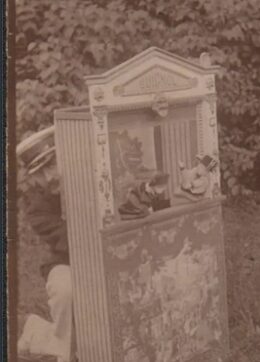
Printed
130 pages
Author(s)
La Dernière Nuit de Don Juan
Edmond Rostand began writing this uncompleted play in 1911. This “dramatic poem with two parts and a prologue” was published posthumously. According to the publishers, the two parts were ready for publication before the First World War, but the prologue was pieced together again from crossed out drafts, and scenic indications were added to clarify the dialogues. The play was staged posthumously in 1922 at the Théâtre de la Porte Saint-Martin (Paris), during a “Edmond Rostand Show”, which began with Les Romanesques (1894) – thus showing the audience “the early work alongside the posthumous one; the first and the last link to the necklace Cyrano wears as a chain” (Jacques Théry, Le Figaro, 8 March 1922).
La Dernière Nuit de Don Juan is meant to be performed by actors, but the play features a mise en abyme in the form a glove-puppet show, which holds a mirror up to Don Juan and lets him know that he never was nothing more than Polichinelle. Georges Gendarme de Bévotte’s famous study, La Légende de Don Juan, Son évolution dans la littérature des origines au Romantisme (Paris: Hachette, 1906), probably influenced the writing of this play, as the many allusions to Tirso de Molina’s, Molière’s, Da Ponte’s or Byron’s versions lead us to believe.
The proud man is punished
The Prologue begins where Molière’s play ended: Don Juan is going down the long stairway into Hell with the statue of the Commander. When he hears Sganarelle scream “My wages!”, he climbs back up to kick his servant, then comes back down. The statue of the Commander is surprised by his courage and offers to bring him back to life. But La Griffe du Diable (The Devil’s Claw) holds Don Juan back by his clothes. In the end, Don Juan is granted another ten years of life, as he makes a deal with La Griffe: during these ten years, he will continue to corrupt women and claim new victims.
Ten years later, this extension is about to come to an end. Don Juan lives in Venice and believes that the Devil has forgotten about him. He is getting ready to have dinner and then go out. A puppeteer is passing in the street, and he invites Don Juan to his home, where he performs his show for him. From the glove-puppet booth, Polichinelle talks to Don Juan, who is reminiscing about the shows he saw as a child. Polichinelle kills Pierrot and Cassandre. He is bitten by a dog then attempts to seduce a doll, using Don Juan’s advice, and finally kills her. Don Juan asks that the puppeteer cut some scenes and get to the moment the Devil takes Polichinelle away. Then he provokes the puppet of the Devil by saying that he would not fear being carried off by him. The puppeteer leaves the booth, reveals that he is the Devil and sits at a table to dine with Don Juan. Don Juan enthuses over his conquests. He asks Sganarelle for the list of the women he seduced, which he then tears up. The Devil turns into a violinist and makes the scraps of paper dance: the Shadows of the one thousand and three women seduced by Don Juan arrive in gondolas. The Devil challenges Don Juan to recognise these women, but he gets them all wrong.
Don Juan, who believed he had seduced and possessed all these women, realises that they had him wrapped around their fingers, and that even the tears they shed because of him were fake. He claims his victories, but he is told that he never did anything with them, and that he never knew how to love. Out of desperation, Don Juan reminds the Devil about the scale of his provocation when he gave a coin to Le Pauvre (The Beggar) “out of love for humanity”. But the Devil makes the Pauvre appear, and the latter throws the coin in Don Juan’s face and forbids him from claiming that he has embodied any kind of revolt. The Devil proves to Don Juan that he was only controlled by ribaldry, like Polichinelle. Rather than sending him to the fires of Hell, which is what the seducer proudly demands, the Devil sentences him to become a puppet in a booth.
First performance
Théâtre de la Porte Saint-Martin
Publications and translations
Edmond Rostand, La Dernière Nuit de Don Juan. Paris: Fasquelle, 1921.
Edmond Rostand, Théâtre. Paris: Omnibus, 2006.
